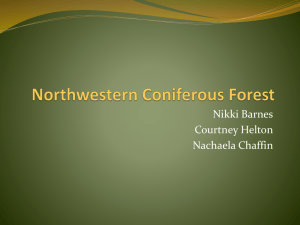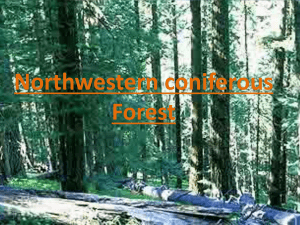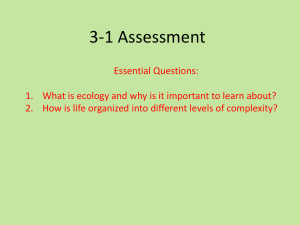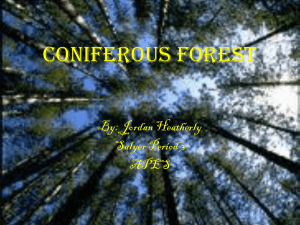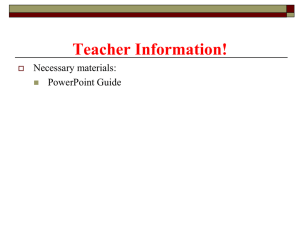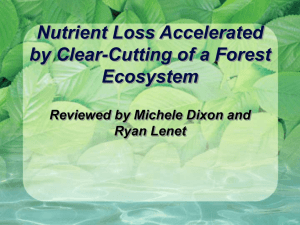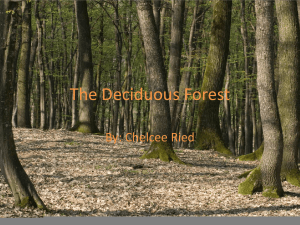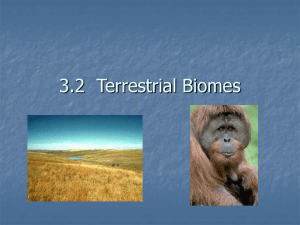Coniferous Forest
advertisement
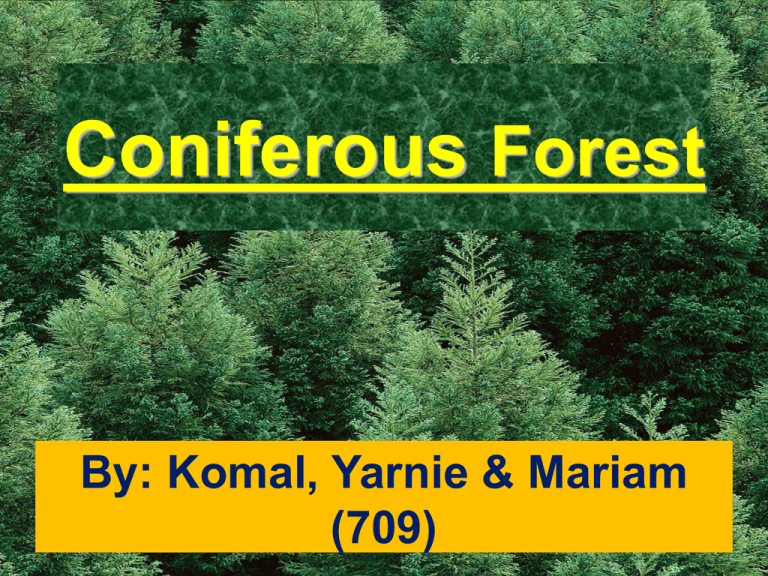
Coniferous Forest By: Komal, Yarnie & Mariam (709) Animal Life By: Background Info • The coniferous forest is home to many animals like grey wolves, yellow jacket, pine-tar vole, field mouse, jack rabbit, lynx, wood-duck, reindeer, weasel, bald eagle, western tanager, gyrfalcon and the common loon. Birds, insects and mammals are very common but reptiles and amphibians are very scarce. Birds and other smaller animals live in trees while the larger ones live on the forest floor. Not many animals live year-round in this forest because of its harsh winters. Animals hibernate or migrate during the winters. But some die of starvation, hypothermia and frostbite. Lynx The lynx is a medium sized cat with long tuffs of hair on its face beside its ears and a short tail. The lynx has large paws which help it walk through the snow. The lynx is 2 ½ feet long and weighs approximately 17 to 25 pounds. Jack Rabbit Head & body are about 21 inches long, ears are 6-7 inches. The jack rabbit weighs 5-7 pounds. The back is brown. Sides are white. Ears are tipped in black Wood- Duck wood ducks have a crested head that is iridescent green and purple with a white stripe leading from the eye to the end of the crest, and another narrower white stripe from the base of the bill to the tip of the crest. The throat is white and the chest is burgundy with white flecks, gradually grading into a white belly. The bill is brightly patterned black, white and red. The legs and feet are a dull straw yellow and the iris is red. Answers to questions • Q#1:What would happen if something were to change the landscape of a particular biome? • A: It would not stay a forest and animals would have no habitat also the food chain would slowly start falling apart each day. • Q#2: What if the temperature were to rise or lower significantly? • A: If the temperature were to change than the vegetation(producers) would not grow and the primary consumers would slowly die of starvation. Answers to questions • Q#3: What if a developer wants to build on the land; what if an animal becomes extinct? • A: If an animal were to become extinct the whole food chain would slowly fall apart. • Q#4: What if a plant were destroyed, or if the rainfall greatly increases or decreases? • A: If the plants were destroyed then the animals that consume them would die of starvation and they would not get enough oxygen. Overall wildlife in the Coniferous Forest: Reindeer, lynx, Yellow jacket, weasel, field mouse, jack rabbit, black bear, gyrfalcon, common loon, wood-duck, gray wolf, bald eagle and the pine-tar vole. Plant life By: Komal (709) Background Info • Coniferous means “cone bearing”. Another name you might hear often about a coniferous forest is “taiga” this also means coniferous forest. Coniferous trees reproduce by dropping cones. The coniferous trees are adapted to the cold winter and are used to living in poor soil and climate qualities. Around 17 billion square miles of the world is covered in coniferous trees. Some examples of plant life are: scotch -pine, blue spruce, Norway pine, mistletoe, red cedar, blue cedar, holly bush, scrub pine black spruce, white spruce, balsam fir, redwood, Douglas fir, white pine, sugar pine, ponderous pine and nootka rose. Red Cedar The Eastern Red Cedar is a very dense, columnar ornamental that is excellent as a windbreak Eastern Red Cedar are not particularly fast growers, but reach heights of 40 feet. Nootka Rose Pink to lilac. Strong fragrance. Large, single (4-8 petals) bloom form. Once-blooming spring or summer. Armed with thorns / prickles, bushy, suckers on its own roots, upright, wellbranched. Small, matte, light green foliage. 5 to 9 leaflets. Height of 2' to 6' (60 to 185 cm). Width of 4' (120 cm). Ponderosa Pine Ponderosa Pine/Yellow Pine. It’s life span is Perennial. Ponderosa pine has a long clear trunk and a high short open crown. It averages 42 inches in diameter and 165 feet tall at maturity. Answers to questions • Q#1: What would happen if something were to change the landscape of a particular biome? • A: It would not stay a forest because there would be no plants which results in no home for the animals so the food web breaks up and we feel a lack of oxygen. • Q#2: What if the temperature were to rise or lower significantly? • A: The plants would start dying because they can’t adapt quick enough resulting in the food chain to end. Answers to questions • Q#3: What if a developer wants to build on the land? • A: Then he would clear cut the forest killing everything and finishing the food chain. • Q#4: What if a plant were destroyed? • A: Then animals would have a problem and die lack of food. Overall plant life in the coniferous Forest: Scotch pine, Mistletoe, blue spruce, red cedar, scrub pine, white pine holly bush, Norway pine, blue cedar, black spruce, red wood, Douglas fir, ponderous pine, nootka rose. Landscape/habitat and weather By : Mariam (709) Background info • The coniferous forest is considered the largest biome in the world. Located near Lake Superior and in the North American lowlands. Most conifers are found in the northern hemisphere but some are in the southern hemisphere. The largest conifers are found in Alaska, Canada and northern Europe. Most conifers are covered in needles all year this is what helps them survive the harsh climate. There isn’t a lot of vegetation • on this forest or good soil so the growing conditions are poor but most of the earth’s plants live there. Background info • Most animals that live here live in trees but a few large animals live on the forest ground. But the Coniferous forest is related low in animal diversity. Some examples of animals are: shrews, voles, squirrels, martens, moose, reindeer, wolves, snakes and frogs. Background info • The coniferous forest is sometimes called a rainforest because of the heavy rain fall. Average precipitation is 1.17-2.46 feet. The coniferous forest has long snowy winters and hot humid summers. In the summers the temperature is about 10 degrees and in the winter the temperature is about -10 degrees. Map of the coniferous forest The coniferous forest is the dark green parts. Food web All the main predators are at the top then they show all the smaller carnivores after that the herbivores lastly the decomposers Climate The Dark green is coniferous forest and it shows that it is usually very cold there. Answers to Questions • Q#1: What would happen if something were to change the landscape of a particular biome? • A: The Coniferous Forest wouldn’t stay a forest anymore all the trees would be gone if that was the change. • Q#2: What if the temperature were to rise or lower significantly • A: The trees would protect themselves. For example: if there was a forest fire, the trees have a thick bark. Answers to Questions • Q#3: What if a developer wants to build on the land? • A: Then the builder would clear cut the forest and there wouldn’t be a forest left anymore. • Q#4: What if a plant were destroyed? • A: There would be less food for the herbivores and they would become extinct. Human influences By: Yarnie And Komal (709) Background info • Humans take a lot from the forest. Our role is to consume and take care of the forest as humans. For Example: we take oils and wood plus material for shelter. We humans need this forest for a lot of different reasons like oxygen, vegetation and shelter. But we also pollute the forest in many different ways like acid rain; we create it, deforestation and global warming. Acid Rain The factories release smoke and the prevailing winds take it over the ocean making it into acid rain. Deforestation When we clear cut the trees in a forest Global Warming When we pollute and greenhouse gases Answers to Questions • Q#1: What would happen if something were to change the landscape of a particular biome? • A: The coniferous trees would not be able to adapt and they would star dying. • Q#2: What if the temperature were to rise or lower significantly? • A: Then it would affect our product and our daily life by the temperature change in the atmosphere. Answers to Questions • Q#3: what if an animal becomes extinct? • A: Then we would lack food from that animal and the forest food chain would fall apart. • Q#4: What if a plant were destroyed? • A: Then the forest food chain would fall apart and eventually the forest would die. Definitions: • 1: Abutting: be next to or touching • 2: Frostbite: injury to the part of a body caused by extreme cold • 3: Hypothermia: The condition of having a very low body temperature • 4: Physical Environment: an environment that you can see, feel and hear • 5: Pollination: carry pollen to and fertilize a flower/plant • 6: Scarce: only available in small quantities or found rarely • 7: Starvation: suffer or die from hunger. Our Questions: • Plant: What is another name for the coniferous forest and what does coniferous mean? • How do coniferous trees survive the harsh climate? • Animal: what are 3 examples of major wildlife? • Why can’t many animals live year round in the forest? • Landscape etc. : Where is the coniferous forest located? • What is the average temperature in the forest? • Human influences: What are 2 ways humans effect the coniferous forest? • What can we do to stop the coniferous forest from dying? • Our links 1. www.dnr.state.mn.us 2. www.britannica.com 3. www.rrms-biomes.tripod.com 4. www.earthobservatory.nasa.gov 5. www.wwfpanda.org 6. www.digital-desert.com • 7. www.idiotica.com Our links 1. www.inchinapinch.com 2. www.enchantedlearning.com 3. www.google.ca 4. www.answers.com 5. www.bookrags.com • 6. www.tutorvista.com • 7. www.teacherfist.com Now a Surprise !!!
